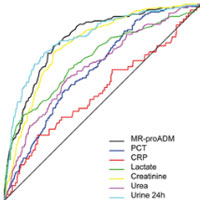Tag: sepsis

Sepsis: Learn the Signs and Document
Writing in the MJA, researchers have reported the findings of a prospective cohort study comparing estimates of the incidence and mortality of sepsis using clinical diagnosis or the Australian and New Zealand Intensive Care... read more

New York State Sepsis Reporting Mandate Appears to Improve Care and Reduce Deaths
A New York State requirement that all hospitals report compliance with protocols to treat severe sepsis and septic shock appears to improve care and reduce mortality from one of the most common causes of death in those who... read more

Hospital Variation in Risk-Adjusted Pediatric Sepsis Mortality
Margaret Parker, MD, MCCM, speaks with Stefanie G. Ames, MD, about the article "Hospital Variation in Risk-Adjusted Pediatric Sepsis Mortality," published in the May 2018 issue of Pediatric Critical Care Medicine. Dr. Ames... read more

Rapid Diagnosis of MRSA
Current standard laboratory methods for detection of oxacillin resistance require for isolation, identification, and susceptibility testing at least 48–72 h, although the multiplex PCR assay used is a rapid, sensitive,... read more

Sepsis Around the Cradle of Humankind
While representing the cutting edge of civilization everywhere, mothers and their newborn infants are a population particularly vulnerable to sepsis.1 By recognizing the importance of antiseptic prophylaxis (handwashing),... read more

MRSA Protocols – Methods in Molecular Biology
Presenting the most up-to-date techniques for the detection, genotyping, and investigation of methicillin-resistant S. aureus (MRSA), this second edition of Methicillin-Resistant Staphylococcus aureus (MRSA) Protocols collects... read more

Epidemiology and Changes in Mortality of Sepsis After the Implementation of Surviving Sepsis Campaign Guidelines
This is a prospective, multicenter, observational study performed during a 5-month period in 2011 in a network of 11 intensive care units (ICUs). We compared our findings with those obtained in the same ICUs in a study conducted... read more

It Makes No Difference – Glucocorticoids for the Treatment of Septic Shock
The administration of a continuous infusion of hydrocortisone to a general population of patients in septic shock on mechanical ventilation cannot be recommended at this time. The authors conclusion that glucocorticoids do... read more

3 Notable Leaps in Sepsis Care
Sepsis is deadly, it's expensive, and there are abundant initiatives underway that could lead to earlier detection, lowering costs, and saving lives. In May 2016, the Healthcare Cost and Utilization Project and the Agency... read more
Watchdog Group Calls for NIH to Halt Dangerous Study of Sepsis Treatment
A medical watchdog group is calling on the National Institutes of Health to immediately stop the enrollment of patients in a clinical trial of sepsis treatment and launch an investigation of how the study received approval,... read more

Predicting the Requirement for RRT in Intensive Care Patients with Sepsis
Sepsis is one of the most frequent causes of acute kidney injury (AKI) in critically ill patients, with initial organ impairment often followed by dysfunction in other systems. Renal dysfunction may therefore represent one... read more

Associations of ICU Capacity Strain with Disposition and Outcomes of Patients with Sepsis Presenting to the Emergency Department
The odds that patients in the ED with sepsis who do not require life support therapies will be admitted to the ICU are reduced when those ICUs experience high occupancy, but not high levels of other previously explored measures... read more

S1PR2 deficiency decreased macrophage pyroptosis and improved survival in E. coli sepsis
Sphingosine-1-phosphate receptor 2 (S1PR2) deficiency decreased macrophage pyroptosis and improved survival in E. coli sepsis. These beneficial effects were attributed to the decreased caspase-11 activation of S1PR2-deficient... read more

Effect of procalcitonin-guided antibiotic treatment on clinical outcomes in ICU patients with infection and sepsis patients
Procalcitonin-guided antibiotic treatment in ICU patients with infection and sepsis patients results in improved survival and lower antibiotic treatment duration. Mortality in the 2252 procalcitonin-guided patients was significantly... read more








